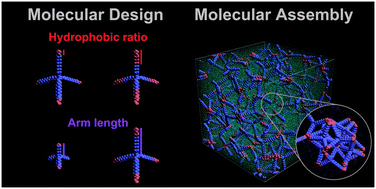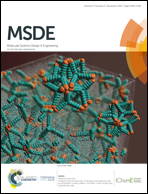Programmed self-assembly of tetrapod nanoparticles with an amphiphilic surface pattern: the effect of arm length and hydrophobic ratio†
Abstract
We studied the self-assembly processes and morphologies of tetrapod nanoparticle solutions using dissipative particle dynamics (DPD) simulations. Composite-shaped nanoparticles, such as a tetrapod model with an amphiphilic surface pattern, were also synthesised experimentally. We programmed nanoparticle self-assembly using the DPD results at various values of the hydrophobic ratio (HR) and arm length (AL). Considering these two parameters, we observed the self-assembly processes and morphologies in a tetrapod nanoparticle solution. As a result, it was found that the HR and AL of tetrapod nanoparticles were effective parameters for controlling their self-assembly processes or structures under equilibrium. In this study, we programmed the AL or HR parameters, and we report their influences on self-assembly. Our simulations offer a guide to controlling the morphologies of self-assembled tetrapod nanoparticles, which constitute novel systems that may find applications in nanofluidic devices.



 Please wait while we load your content...
Please wait while we load your content...